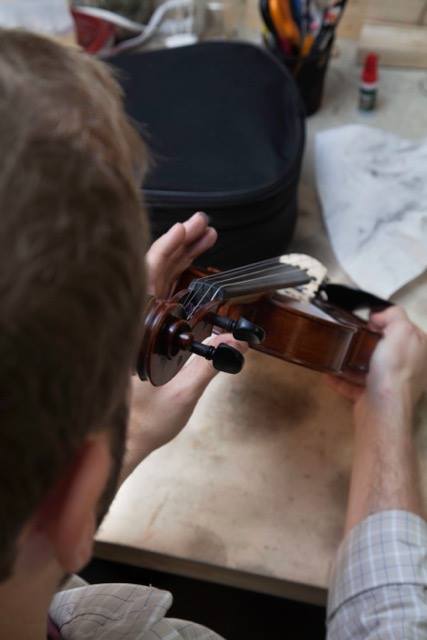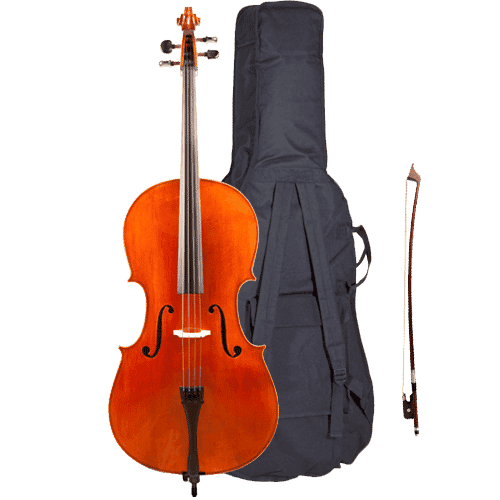Choosing between the violin and cello can feel like standing at a crossroads in your musical journey. Each instrument sings its unique song, with the violin’s high, clear notes weaving through the air like quicksilver and the cello’s deep, soulful tones echoing the depths of the heart. Whether you’re a budding musician taking your first steps or a seasoned player contemplating a change, this decision shapes your musical voice. So, let’s unravel this melodious dilemma together. Here’s a friendly guide to help you choose which stringed companion – the elegant violin or the majestic cello – resonates best with your musical soul.
Historical Context and Evolution Of Both The Violin and Cello
Imagine the bustling streets of Renaissance Europe, where the earliest ancestors of these stringed instruments emerged. The violin, known for its agility and flair, evolved from the viola da braccio family in the 16th century in Italy. Its purpose? To dazzle listeners with its high-pitched, vibrant sounds, perfect for the spirited dances and courtly music of the time.
On the other side, the cello, with its deep, resonating voice, is like the wise elder of the string family. It stemmed from the viola da gamba family and was initially more of a background instrument, providing a sturdy foundation for ensembles. Over time, as music evolved, the cello stepped into the spotlight, showcasing its ability to convey a range of emotions, from melancholic lows to soaring highs.
Understanding this journey, from the humble beginnings of orchestral music to today’s concert halls, adds layers of appreciation and might sway your heart towards one over the other. The cello speaks a language of depth and emotion, while the violin sings a song of brightness and complexity. So, before visiting the online violin shop, it’s good to know their differences.
The Main Differences Between a Violin and a Cello
At first glance, violins and cellos might seem like different sizes of the same string family, but the truth runs deeper. Each string instrument differs in playing technique, bass sounds, and more. These stringed instruments carry distinct personalities, from physical attributes to unique sounds. Let’s delve into their key differences.
Sizing
The difference between a violin and a cello is immediately noticeable regarding sizing.
Violin: Imagine the violin as a delicate, lightweight musical instrument, easily nestled under the chin, offering flexibility to play standing or comfortably seated. It’s perfect for the musician on the move.
Cello: Picture the cello: grand and stately. It demands a seated position, cradled between the knees. This larger size translates to less portability but adds a sense of majesty to its presence.
So, while violins win in the travel-friendly department, cellos stand out with their impressive stature and commanding poise. So, violins are ideal if you are embarking on a musical journey. So, buy violins for sale for your next travel adventure.
Sound
While both instruments are members of the string family, their sounds couldn’t be more distinct.
Violin: The violin, with its bright, high-pitched tones, dances effortlessly across melodies, fitting seamlessly into various musical genres. It’s like a sparkling stream of sound, lively and energetic, that aids all types of music- be it classical music or Jazz.
Cello: The cello, endowed with a larger body, produces a sound that’s deep and rich, akin to a resonant echo in a vast hall. Its tones range from comforting, warm lows to emotionally charged highs, mirroring the nuanced inflections of the human voice. The fittings of cello strings make all the difference.
This difference in sound character adds a unique flavor to each instrument’s musical expression.
String and Tuning

Indeed, the violin and cello boast four strings, yet their tuning sets them apart.
Violin: The violin strings, tuned to G, D, A, and E, ascend to higher pitches, giving it a bright, sharp sound perfect for leading and harmonizing.
Cello: The strings are tuned to C, G, D, and A, an octave lower, producing more profound, resonant notes.
This variance in tuning not only influences the kind of music written for each but also defines their distinctive roles within an ensemble, with the violin often taking the lead and the cello providing a rich, supportive base.
Bow
The bows for violin and cello are subtly distinct in size and weight, shaping the player’s technique and expression.
Violin: The violin bow, being lighter and shorter, calls for a more delicate, precise control, ideal for quick, agile movements. You can play the violin as smoothly as the cello.
Cello: The cello bow, with its added length and heft, demands a more robust, more grounded approach, allowing for broader, more forceful strokes.
These differences greatly influence how a musician articulates notes and controls dynamics, adding unique character to each instrument’s sound.
Repertoire
The repertoire for both violin and cello is rich and distinct in their musical roles.
Violin: The violin, often at the forefront, shines in orchestras and quartets, boasting a plethora of virtuosic pieces that showcase its nimble and expressive capabilities.
Cello: Meanwhile, the cello’s repertoire, though equally impressive, highlights its versatile nature. It provides deep, resonant harmonies and captivating solo melodies, making it a cornerstone in ensembles.
This diversity in repertoire allows each instrument to display its unique strengths and character.
Price
When comparing the price of violins and cellos, it’s essential to consider how their differences in size and construction affect their cost.
Violin: Starting with violins come in a range of prices that cater to all levels of musicians, from beginners to professionals. Affordable options are available for those just starting, with prices increasing as the quality and craftsmanship of the instruments improve. High-end violins, especially those crafted by renowned luthiers, can be expensive but are prized for their exceptional sound and build quality.
Cello:Cello instruments, due to their larger size and the increased amount of material needed for their construction, generally have a higher price point. Even at the beginner level, cellos tend to be more costly than their violin counterparts. As one moves towards professional-grade cellos, the prices can escalate significantly, reflecting the meticulous craftsmanship and quality of the materials, and this makes cellos, particularly those of superior quality, a more substantial financial investment than violins.
For aspiring musicians, this difference in pricing is a crucial factor to consider when choosing between these beautiful string instruments.
Appearance and Style
Violin: With its elegant and compact form, the violin exudes a charm of grace and finesse. Its sleek design and smaller size make it visually appealing and offer a sense of intimacy and closeness to the player.
Cello: The cello, commanding a robust and majestic presence, stands out with its grandeur and stately appearance. Its larger size and bold silhouette can be striking, resonating with those who appreciate a more pronounced physical presence in their instrument.
Ultimately, the choice between the two can reflect a musician’s aesthetic and how they resonate with the instrument’s visual and tactile characteristics.
Physical Comfort and Ergonomics
When choosing between the violin and cello, it’s essential to consider each instrument’s physical demands and comfort levels.
Violin: The violin, with its lightweight and smaller size, is often more manageable, especially for younger players or those with smaller frames. However, holding the violin under the chin and using the shoulder rest can be challenging for some, requiring good posture and neck support.
Cello: The larger cello means it rests on the floor, supported between the knees, and this can be more comfortable for longer practice sessions, allowing for a more natural sitting posture. However, the size and weight of the cello can be challenging for smaller individuals or those with physical limitations.
Community and Ensemble Opportunities
When deciding between the violin and cello, it’s worthwhile to consider the variety of ensemble opportunities available for each.
Violin: Violinists often find many options, as violins are a staple in most orchestral and chamber music settings. Their versatile nature allows violinists to shine in various genres, from classical symphonies to string quartets and even folk or contemporary bands.
Cello: Cellists, though fewer in number compared to violinists, also enjoy significant ensemble roles. The cello’s rich, deep tones add depth and warmth to an orchestra’s sound. Cellists often find their niche in symphony orchestras, chamber music groups, and quartets.
Personal Goals and Musical Preferences
When choosing between the violin and cello, reflecting on your musical tastes and long-term goals is crucial.
Violin: If your passion lies in playing soaring, intricate melodies. And bright, agile sounds draw your attention. Then, the violin might be your ideal match. It’s perfect for those aspiring to be front-and-center in performances in classical or contemporary genres.
Cello: If you’re captivated by rich, deep tones and enjoy playing harmonic and melodic lines, the cello could align more with your musical aspirations. Its versatility makes it an excellent fit for those who see themselves in diverse roles across various musical styles, from a soloist to an integral part of an ensemble.
Your choice should resonate with the type of music you love and the role you envision for yourself in your musical journey.
Learning Curve and Accessibility
When considering the violin and cello, it’s essential to consider the learning curve and accessibility for beginners. Both instruments have their unique challenges.
Violin: The violin, with its smaller size and higher pitch, requires precise finger placement and bowing technique to produce clear, in-tune notes. It can take some time for beginners to develop the fine motor skills needed for this level of precision. If you face instrument issues, you can try violin repair services to adjust them to your requirements.
Cello: While more forgiving regarding finger placement due to its larger size, the cello demands a good understanding of posture and weight distribution. Beginners may find it easier to produce a pleasant sound early on, but mastering the nuances of bowing and vibrato on the cello can be equally challenging.
Conclusion
Whether you lean towards the vibrant, expressive violin or the soulful, resonant cello, each path offers a unique and fulfilling musical experience. As you weigh your options, remember that the best choice is not about which instrument is superior but which resonates more with your aspirations, physical comfort, and the kind of music that stirs your soul. Consider the practical aspects, but also listen to your heart. Your instrument should feel like an extension of yourself, a companion on your musical journey that enhances your expression and joy in music. Whichever you choose, the journey ahead is rich with potential for growth, creativity, and the profound pleasure of making music.
